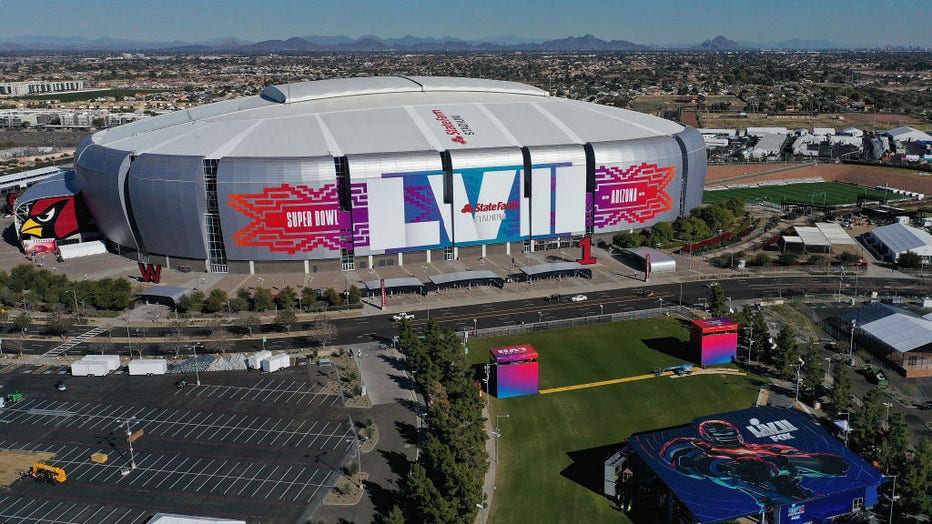How Super Bowl LVII puts a spin on the classic grass field
The Philadelphia Eagles and Kansas City Chiefs will soon descend on Arizona's State Farm Stadium for Super Bowl LVII and will get the chance to play on newly grown sod thanks to technology only in use by a few stadiums across the country.
The facility in Glendale, Arizona, is one of the two NFL sites with the capability to grow its grass playing field outside and roll it inside ahead of games. The $1.8 Billion Allegiant Stadium, home to the Las Vegas Raiders, is the other NFL facility fortunate enough to have a retractable field.
State Farm Stadium officials maintain the grass has the feel and playability of a traditional playing surface.
"The roll-out natural grass playing field is contained in a single 40-inch-deep tray measuring 234 feet wide and 403 feet long," State Farm Stadium said. "Rolling on 546 steel wheels which rest on 13 railroad-like tracks, the field travels the 740 feet inside or out of the stadium."

State Farm Stadium, formerly University of Phoenix Stadium, keeps their grass outside to grow before taking it in for each sporting event. (Gene Lower /Sports Illustrated / Getty Images)
State Farm Stadium uses a hybrid Bermuda grass and boasts that it was the first facility in North America to incorporate a retractable playing surface for the grass. It does so to take advantage of the maximum sunshine and nourishment in the usually warm desert sun.
ARTIFICIAL TURF VS. REAL GRASS: NFL'S ONGOING PROBLEM WITH PLAYING SURFACES
"It’s called Tahoma 31 Bermuda grass. We grow this on plastic. The reason we do this is to kind of trap the roots in the grass, and it makes it stronger not only for the players but also for the halftime show, which sometimes it could be 6 to 10000 pounds for the stage," said Jay Danek, general manager for West Coast Turf. West Coast Turf provides the specialty grass for several NFL teams, including the sod for this year’s Super Bowl.
Despite the desert location, precipitation is possible year-round, with the region seeing its heaviest rainfall during the monsoon season.
The special grass playing encountered precipitation problems ahead of the Super Bowl
Even though the Phoenix area averages four months a year with temperatures that reach over 100 degrees and little rain, recent sunshine was blocked by storms, which impacted the installation of new grass for the Super Bowl.
The desert doesn’t often get rain, but Danek said that that's all they were getting in mid-January as they prepared to install grass for Super Bowl LVII.

Stormy weather makes it hard for crews to transfer the sod to State Farm Stadium for the Super Bowl. (Jay Danek/West Coast Turf / FOX Weather)
"In the last four weeks, we’ve actually got 3.5 inches in Scottsdale, which is half of our yearly amount," Danek said about the rain received at their farm, which is located about 25 miles from the stadium.
HEAVY RAIN FLOODS SOLDIER FIELD DURING CHICAGO BEARS' SEASON OPENER AGAINST SAN FRANCISCO 49ERS
And while you’d think the rain would be good for the grass, it’s actually the opposite when you’re trying to transport it and install it at another location.
"It’s extremely difficult to harvest sod when it's wet, it becomes muddy," Danek said. "The last thing we want to do is streak the grass when we're sending it. You roll it up and (at) 2,500 pounds, and it'll turn black when it's muddy."
In the week that it took to install the grass for the Super Bowl, the area saw rain nearly every day of their installation. Glendale received nearly two-thirds of the amount of rain they see in January in just three days, and some locations within the area saw more than their monthly averages.
CHICAGO BEARS INSTALLING NEW TURF AT SOLDIER FIELD AHEAD OF SEASON OPENER AGAINST 49ERS
And while chances are low that more rain could happen during the Super Bowl, State Farm Stadium has a retractable roof than can seal off the facility for the more than 63,000 fans should storms form.

In an aerial view of State Farm Stadium on January 28, 2023 in Glendale, Arizona. State Farm Stadium will host the NFL Super Bowl LVII on February 12. (Christian Petersen / Getty Images)
The stadium typically keeps the roof closed during early-season football games but will likely have it open during the Super Bowl. High temperatures for Super Bowl LVII will be in the low-70s.
The Philadelphia Eagles will take on the Kansas City Chiefs for Super Bowl LVII at 4:30 p.m. MST on FOX.

